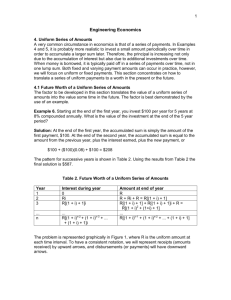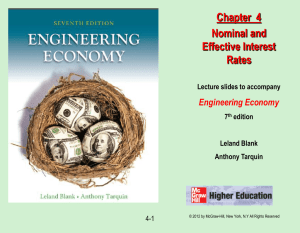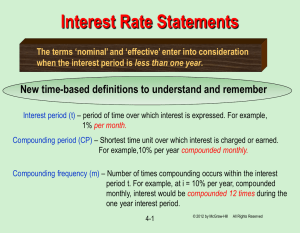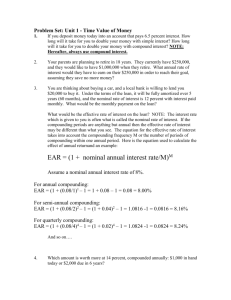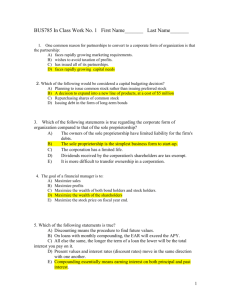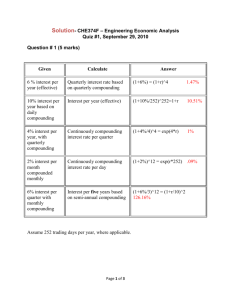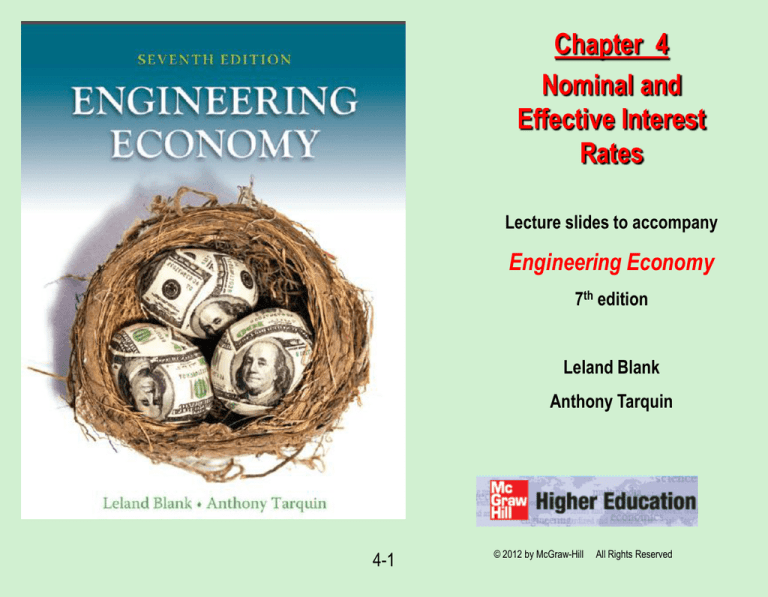
Chapter 4
Nominal and
Effective Interest
Rates
Lecture slides to accompany
Engineering Economy
7th edition
Leland Blank
Anthony Tarquin
4-1
© 2012 by McGraw-Hill
All Rights Reserved
LEARNING OUTCOMES
1. Understand interest rate statements
2. Use formula for effective interest rates
3. Determine interest rate for any time period
4. Determine payment period (PP) and compounding
period (CP) for equivalence calculations
5. Make calculations for single cash flows
6. Make calculations for series and gradient cash flows
with PP ≥ CP
7. Perform equivalence calculations when PP < CP
8. Use interest rate formula for continuous compounding
9. Make calculations for varying interest rates
4-2
© 2012 by McGraw-Hill
All Rights Reserved
Interest Rate Statements
The terms ‘nominal’ and ‘effective’ enter into consideration
when the interest period is less than one year.
New time-based definitions to understand and remember
Interest period (t) – period of time over which interest is expressed. For example,
1% per month.
Compounding period (CP) – Shortest time unit over which interest is charged or earned.
For example,10% per year compounded monthly.
Compounding frequency (m) – Number of times compounding occurs within the interest
period t. For example, at i = 10% per year, compounded
monthly, interest would be compounded 12 times during the
one year interest period.
4-3
© 2012 by McGraw-Hill
All Rights Reserved
Understanding Interest Rate Terminology
A nominal interest rate (r) is obtained by multiplying an interest rate that is
expressed over a short time period by the number of compounding periods in a
longer time period: That is:
r = interest rate per period x number of compounding periods
Example: If i = 1% per month, nominal rate per year is
r = (1)(12) = 12% per year)
Effective interest rates (i) take compounding into account (effective rates
can be obtained from nominal rates via a formula to be discussed later).
IMPORTANT: Nominal interest rates are essentially simple interest rates. Therefore,
they can never be used in interest formulas.
Effective rates must always be used hereafter in all interest formulas.
4-4
© 2012 by McGraw-Hill
All Rights Reserved
More About Interest Rate Terminology
There are 3 general ways to express interest rates as shown below
Sample Interest Rate Statements
Comment
(1)
i = 2% per month
i = 12% per year
When no compounding period
is given, rate is effective
(2)
i = 10% per year, comp’d semiannually
i = 3% per quarter, comp’d monthly
When compounding period is given
and it is not the same as interest
period, it is nominal
i = effective 9.4%/year, comp’d semiannually
(3)
i = effective 4% per quarter, comp’d monthly
When compounding period is given
and rate is specified as effective,
rate is effective over stated period
4-5
© 2012 by McGraw-Hill
All Rights Reserved
Effective Annual Interest Rates
Nominal rates are converted into effective annual rates via the equation:
ia = (1 + i)m – 1
where ia = effective annual interest rate
i = effective rate for one compounding period
m = number times interest is compounded per year
Example: For a nominal interest rate of 12% per year, determine the nominal
and effective rates per year for (a) quarterly, and (b) monthly compounding
Solution: (a) Nominal r / year = 12% per year
Nominal r / quarter = 12/4 = 3.0% per quarter
Effective i / year = (1 + 0.03)4 – 1 = 12.55% per year
(b) Nominal r /month = 12/12 = 1.0% per year
Effective i / year = (1 + 0.01)12 – 1 = 12.68% per year
4-6
© 2012 by McGraw-Hill
All Rights Reserved
Effective Interest Rates
Nominal rates can be converted into effective rates
for any time period via the following equation:
i = (1 + r / m)m – 1
where
i = effective interest rate for any time period
r = nominal rate for same time period as i
m = no. times interest is comp’d in period specified for i
Spreadsheet function is = EFFECT(r%,m) where r = nominal rate per period specified for i
Example: For an interest rate of 1.2% per month, determine the nominal
and effective rates (a) per quarter, and (b) per year
Solution:
(a) Nominal r / quarter = (1.2)(3) = 3.6% per quarter
Effective i / quarter = (1 + 0.036/3)3 – 1 = 3.64% per quarter
(b) Nominal i /year = (1.2)(12) = 14.4% per year
Effective i / year = (1 + 0.144 / 12)12 – 1 = 15.39% per year
4-7
© 2012 by McGraw-Hill
All Rights Reserved
Equivalence Relations: PP and CP
New definition: Payment Period (PP) – Length of time between cash flows
In the diagram below, the compounding period (CP) is semiannual and the payment period (PP) is monthly
$1000
Similarly, for the diagram below, the CP is quarterly and the payment period (PP) is semiannual
F=?
i = 10% per year, compounded quarterly
0
1
0
2
1
2
3
3
4
4
5
6
5
7
8
Years
Semi-annual periods
A = $8000
Semi-annual PP
4-8
© 2012 by McGraw-Hill
All Rights Reserved
Single Amounts with PP > CP
For problems involving single amounts, the payment period (PP) is usually
longer than the compounding period (CP). For these problems, there are an infinite
number of i and n combinations that can be used, with only two restrictions:
(1) The i must be an effective interest rate, and
(2) The time units on n must be the same as those of i
(i.e., if i is a rate per quarter, then n is the number of quarters between P and F)
There are two equally correct ways to determine i and n
Method 1: Determine effective interest rate over the compounding period CP, and
set n equal to the number of compounding periods between P and F
Method 2: Determine the effective interest rate for any time period t, and
set n equal to the total number of those same time periods.
4-9
© 2012 by McGraw-Hill
All Rights Reserved
Example: Single Amounts with PP ≥ CP
How much money will be in an account in 5 years if $10,000 is deposited
now at an interest rate of 1% per month? Use three different interest
rates: (a) monthly, (b) quarterly , and (c) yearly.
(a) For monthly rate, 1% is effective [n = (5 years)×(12 CP per year = 60]
F = 10,000(F/P,1%,60) = $18,167
months
effective i per month
i and n must always
have same time units
(b) For a quarterly rate, effective i/quarter = (1 + 0.03/3)3 –1 = 3.03%
F = 10,000(F/P,3.03%,20) = $18,167
quarters
effective i per quarter
i and n must always
have same time units
(c) For an annual rate, effective i/year = (1 + 0.12/12)12 –1 = 12.683%
F = 10,000(F/P,12.683%,5) = $18,167
years
effective i per year
4-10
© 2012 by McGraw-Hill
i and n must always
have same time units
All Rights Reserved
Series with PP ≥ CP
For series cash flows, first step is to determine relationship between PP and CP
Determine if PP ≥ CP, or if PP < CP
When PP ≥ CP, the only procedure (2 steps) that can be used is as follows:
(1) First, find effective i per PP
Example: if PP is in quarters, must find effective i/quarter
(2) Second, determine n, the number of A values involved
Example: quarterly payments for 6 years yields n = 4×6 = 24
Note: Procedure when PP < CP is discussed later
4-11
© 2012 by McGraw-Hill
All Rights Reserved
Example: Series with PP ≥ CP
How much money will be accumulated in 10 years from a deposit
of $500 every 6 months if the interest rate is 1% per month?
Solution: First, find relationship between PP and CP
PP = six months, CP = one month; Therefore, PP > CP
Since PP > CP, find effective i per PP of six months
Step 1.
i /6 months = (1 + 0.06/6)6 – 1 = 6.15%
Next, determine n (number of 6-month periods)
Step 2: n = 10(2) = 20 six month periods
Finally, set up equation and solve for F
F = 500(F/A,6.15%,20) = $18,692 (by factor or spreadsheet)
4-12
© 2012 by McGraw-Hill
All Rights Reserved
Series with PP < CP
Two policies: (1) interperiod cash flows earn no interest (most common)
(2) interperiod cash flows earn compound interest
For policy (1), positive cash flows are moved to beginning
of the interest period in which they occur
and negative cash flows are moved to the end of the interest period
Note: The condition of PP < CP with no interperiod interest is the only situation
in which the actual cash flow diagram is changed
For policy (2), cash flows are not moved and equivalent P, F, and A values are
determined using the effective interest rate per payment period
4-13
© 2012 by McGraw-Hill
All Rights Reserved
Example: Series with PP < CP
A person deposits $100 per month into a savings account for 2 years. If
$75 is withdrawn in months 5, 7 and 8 (in addition to the deposits),
construct the cash flow diagram to determine how much will be in the
account after 2 years at i = 6% per year, compounded quarterly. Assume
there is no interperiod interest.
Solution: Since PP < CP with no interperiod interest, the cash flow diagram must be
changed using quarters as the time periods
F=?
75
75 75
F=?
from
75
to
0
1 2 3 4 5 6 7 8 9 10
23 24
this
this
0 1 2 3 4 5 6 7 8 9 10
1
300
100
4-14
150
21
24
2
3
7
8
300
300
300
300
© 2012 by McGraw-Hill
All Rights Reserved
Months
Quarters
Continuous Compounding
When the interest period is infinitely small, interest is
compounded continuously. Therefore, PP > CP and m increases.
Take limit as m → ∞ to find the effective interest rate equation
i = er – 1
Example: If a person deposits $500 into an account every 3 months
at an interest rate of 6% per year, compounded continuously,
how much will be in the account at the end of 5 years?
Solution:
Payment Period: PP = 3 months
Nominal rate per three months: r = 6%/4 = 1.50%
Effective rate per 3 months: i = e0.015 – 1 = 1.51%
F = 500(F/A,1.51%,20) = $11,573
4-15
© 2012 by McGraw-Hill
All Rights Reserved
Varying Rates
When interest rates vary over time, use the interest rates
associated with their respective time periods to find P
Example: Find the present worth of $2500 deposits in years 1 through 8 if the
interest
rate
isflow
7%shown
per year
firstworth
five(inyears
per
For the
cash
below,for
find the
the future
year 7)and
at i = 10%
10% per
year.year thereafter.
Solution:
P = 2,500(P/A,7%,5) + 2,500(P/A,10%,3)(P/F,7%,5)
= $14,683
An equivalent annual worth value can be obtained by replacing each cash flow
amount with ‘A’ and setting the equation equal to the calculated P value
14,683 = A(P/A,7%,5) + A(P/A,10%,3)(P/F,7%,5)
A = $2500 per year
4-16
© 2012 by McGraw-Hill
All Rights Reserved
Summary of Important Points
Must understand: interest period, compounding period, compounding
frequency, and payment period
Always use effective rates in interest formulas
i = (1 + r / m)m – 1
Interest rates are stated different ways; must know how to get effective rates
For single amounts, make sure units on i and n are the same
4-17
© 2012 by McGraw-Hill
All Rights Reserved
Important Points (cont’d)
For uniform series with PP ≥ CP, find effective i over PP
For uniform series with PP < CP and no interperiod interest, move
cash flows to match compounding period
For continuous compounding, use i = er – 1 to get effective rate
For the cash flow shown below, find the future worth (in year 7) at i = 10% per year.
For varying rates, use stated i values for respective time periods
4-18
© 2012 by McGraw-Hill
All Rights Reserved


